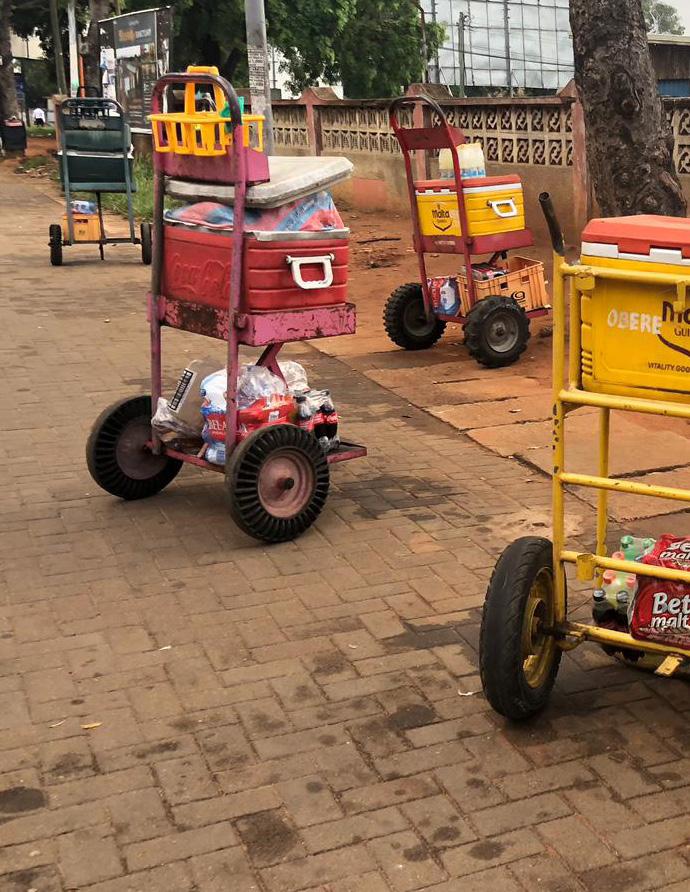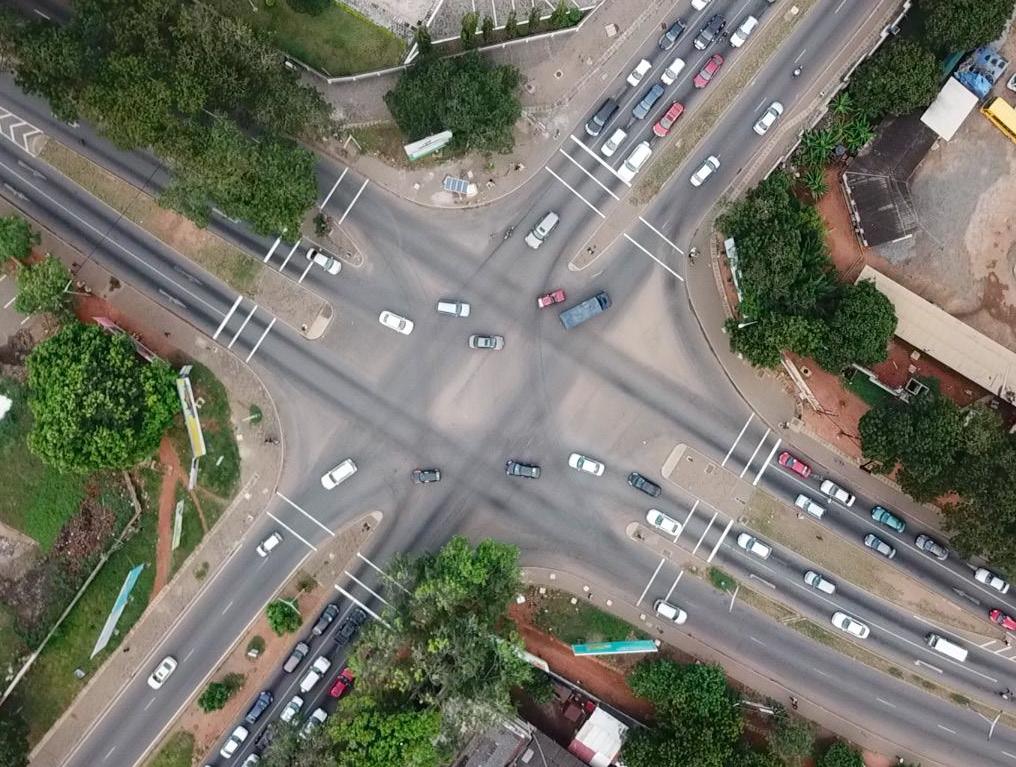
12 minute read
Cathedral Junction
History, Current Context, and Land Use
Cathedral Junction, the intersection of two major commuting arteries— Barnes and Castle Roads—is located between the Adabraka and West Ridge neighborhoods of Accra. The intersection functions mainly as a thoroughfare to major employment centers in the adjacent neighborhoods of North Ridge and West Ridge.
The intersection is surrounded by institutional and civic buildings, including the Holy Spirit Cathedral (the seat of Accra’s Roman Catholic bishop) located on the northwest corner. Eastward, two hospitals— Accra Psychiatric Hospital and Adabraka Polyclinic—along with a
BARNES RD medical training school, flank Castle Road. The Accra Rehabilitation Center sits at the southeast corner.
N CASTLE RD
Site Analysis in all directions, is several hundred meters. As such, pedestrian jaywalking is exceedingly common Streets, Blocks & in Cathedral Junction, as people Sidewalks would rather cross in the middle of the block than walk to the next The wide streets and large blocks corner. Though all four sides of the surrounding Cathedral Junction junction have significant mid-block reflect modern engineering pedestrian traffic, there is a midstandards that prioritize smooth block crosswalk only on the eastern vehicular traffic flows. segment of Castle Road. Most people crossing here are employees Cathedral Junction displays or patients of the hospitals, leaving generally functional street and to purchase food from stationary sidewalk infrastructure designed vendors in the morning or catch primarily for motor traffic. The transportation in the evening. multi-lane roads are well-paved Some patients must cross from with demarcated traffic lanes. Like one side to the other to travel Wato Junction, motor traffic lights between medical appointments. are functional, and automobiles observe signals and traffic rules—motorcycles do not. The Open Space western and southern segments of Castle and Barnes Roads provide tree-lined pedestrian refuges. Sidewalks are generally evenly paved and free of trash. Public open space, in the form of wide curbs, is located on each corner of Cathedral Junction. Although these corners are largely unpaved, overgrown, and However, as with Wato Junction, pedestrian infrastructure exhibits a low level of standardization and maintenance at Cathedral Junction. blocked by utilities and billboard columns, they are used by mobile vendors and pedestrians for congregation and respite. Although motor traffic lights are present and functional, there are only two pedestrian lights—one across Barnes Road and the other across Castle Road. They are either dysfunctional or out-of-sync with motor traffic lights. Sidewalks suffer from low levels of maintenance with obstructions such as broken drainage covers (on the east and south segments of Castle and Barnes Roads, respectively), rocks, On the northwest corner, mature trees offer pedestrians protection from the sun and rain. This corner has the most pavement of any at the Junction, allowing vendors to set up chairs and small tables on the even surface. However, billboards impede some pedestrian access to the sidewalk. Hawkers vend along the Barnes Road side of the corner during the morning rush hour. and trees. The lack of ramps also poses a major challenge to access by the Cathedral intersection’s vulnerable populations. The variations in sidewalk width along road segments also indicate a lack of appropriate standardization. Similarly, the very thin pedestrian refuge on the north segment of Barnes Road creates danger for pedestrians crossing the road. At the northeast corner, open space is used primarily by pedestrians passing through the intersection. The open space beyond the sidewalk is unpaved and blocked by a line of billboard columns, making for an uncomfortable and inconvenient place to gather. However, farther eastward along Castle Road, a line of mature trees creates a comfortable location The distance between Cathedral Junction and the next intersection, for stationary vendors to sell their wares throughout the day from semi-permanent stalls. The southeast corner is distinct, and offers two options for pedestrian passage, with a sidewalk at street level and an unpaved walking path at a lower elevation along Castle Road. Small trees separate the sidewalk from the walking path, making the path the more comfortable and protected of the two spaces. Vendors congregate along this path, taking advantage of the wide space to also park their carts. Finally, although the southwest corner of the intersection is marked by overgrowth and billboard columns, it is used for access and congregation. Pedestrians walk across well-trodden paths in the weeds, and vendors have made seating out of the masonry walls. Along Castle Road, vendors use the utility poles to display their wares.
Circulation
The roadway system at Cathedral Junction comprises two streets, both bearing two-way vehicular traffic. Its main north-south street, Barnes Road, branches off from arterial streets near the Kwame Nkrumah Interchange and carries traffic to and from the coast. The main east-west street, Castle Road, carries traffic to and from the Osu neighborhood to the west and the River Odaw to the east. Formal public bus lines travel along both Barnes Road and Castle Road, making stops past each corner of the intersection. Trotros and taxis also stop infrequently at the bus turnouts to pick up and drop off passengers. Pedestrian crossings at the intersection are set back past the turning radius of each corner. A midblock pedestrian crossing located eastward on Castle Road allows for pedestrian circulation between the Accra Psychiatric Hospital and the Adabraka Polyclinic. No bicycle infrastructure exists.
At the aggregate level, both vehicular and pedestrian traffic flows at Cathedral Junction are similar across the three peak periods. Around 65 vehicles per minute
flowed through the intersection (in any direction) and 5 pedestrians per minute made crossings at each sampled period (Figure 10).
Morning Peak Period. The morning peak period experiences significant southbound vehicle traffic along Barnes Road towards the Central Business District. According to the collected vehicle traffic count data, approximately 177 vehicles flowed per 10 minutes in the abovementioned direction. In contrast, the northbound vehicular traffic observed on Barnes Road was approximately 94 vehicles per 10 minutes. The highest vehicular traffic volume was observed eastwards on Castle Road at about 246 vehicle flows per 10 minutes, while the westward flow was approximately half that rate, at about 125 vehicles per 10 minutes. (Figure 14)
The observed pedestrian flows were less than one-tenth that of vehicle flows (Figure 10). On average, 35 pedestrians crossed Barnes Road during the 10-minute period, while 14 pedestrians crossed Cathedral Road over each 10-minute period.
Afternoon Period. Pedestrian and traffic flows are very similar in the morning and afternoon periods. The vehicle traffic count data show approximately 640 vehicles flowing per 10 minutes in the morning and 650 in the afternoon. The pedestrian flows are similar at approximately 50 pedestrians per 10 minutes in the morning and 40 pedestrians per 10 minutes in the afternoon. The direction of traffic is similar to the morning southbound pattern.
Evening Peak Period. In contrast with the morning, the evening peak period sees a reversal in vehicle traffic along Barnes Road in the northward direction with an average of 229 vehicles flowing per 10 minutes. The southward flow on Barnes Road is less than half that rate, at approximately 97 vehicles per 10 minutes. The eastward vehicle flow on Castle Road was again higher than the westward flow, at 179 vehicles per 10 minutes and 159 vehicles per 10 minutes, respectively (Figure 15). During the evening, pedestrian flows across Barnes and Castle Roads were equal, with 25 pedestrian crossings occurring per 10-minute period on both roads. (Figure 16)
Parking
Motorcycles, taxis, and tro-tros do not frequently park or stop in Cathedral Junction as it is mainly a thoroughfare and not a residential area. There are two bus stops with curb extensions that tro-tros, taxis, and private cars use temporarily, mostly for people accessing the hospitals. These transportation stops generate mid-block pedestrian traffic. though less severe placement issue, as 22 percent of pedestrians choose to cross in front of the crosswalk.
Unlike Wato Junction, the predominantly institutional land use around Cathedral Junction means that school children do not make up a large share of pedestrians crossing the intersection. There are only a handful of schools and educational programs in the vicinity of the intersection including Springboard School Osu, Adabraka Presby Basic School, Bethel Kids International School, Merton International School, and Accra High School. Land use layout and the predominance of private schools suggest that most children can commute to school without having to cross the intersection.
Although many persons with disabilities and elderly persons attend the church and hospitals in Cathedral Junction, many do so by car. However, those who do use the intersection must contend with several accessibility challenges. The crosswalk on the west side of Barnes Road is placed such that the tree in the median is in the middle of the crosswalk, creating a diversion for pedestrians. None of the crosswalks are wheelchair accessible, nor do they have non-visual or audible cues for the visually impaired.
Furthermore, many vendors carry carts or loads of wares through the intersection. The crossing distances are very long for slower pedestrians to make it in the allotted time. Additionally, motorcyclists often run red lights, putting all pedestrians at risk even those properly crossing the streets. Broken sidewalks and open sewers are hazardous for pedestrians—especially those in wheelchairs or with carts—but they do not cause pedestrians to detour onto roadways.
Major Categories of Users
Pedestrians
Using the same categories of pedestrians used for Wato, we find that general pedestrians constitute 82 percent of those walking at Cathedral Junction, while school children make up 7 percent, those carrying loads make up another 7 percent, and the elderly and the vulnerable comprise the remaining 5 percent. (Figure 11)
As previously noted, jaywalking is common at Cathedral. As many as 65 percent of pedestrians choose to cross mid-block. Of the pedestrians crossing between the north and south sides of Castle Road midblock, only 6 percent use the provided crosswalk. A full 71 percent of pedestrians walking along Barnes Road cross Castle Road in front of the crosswalk. The crosswalks across Barnes Road have a similar,
Cathedral Junction is a prime location for street hawkers. Although vendors were not included in the pedestrian counts crossing Cathedral Junction, they make up a significant share of the foottraffic in the intersection. The nature of vending in Cathedral Junction is shaped entirely by its function as a major commuting corridor. Vendors mainly target and sell to vehicle traffic. This pattern is evidenced by vendors’ goods and their selling strategy.
Vendors in Cathedral Junction are extremely mobile, usually carrying their goods and weaving in and out of lines of traffic stopped at red lights. As this is not a market center, they depend on impulse purchasing decisions from people passing in vehicles. They sell cold drinks, snacks, and small housewares. Vendors selling food comprise 43 to 55 percent of total market share with housewares claiming 25 to 29 percent. Street vending density increases throughout the day, presumably selling to homebound commuters and taking advantage of the afternoon heat to sell cold drinks and snacks. Despite their presence in the street during red lights, vendors do not contribute to traffic congestion or back-ups in Cathedral Junction. Vendors are quick to move out of the street when the light turns green, allowing vehicles to move freely.
Stationary vendors mainly sell prepared meals (76 to 80 percent of market share) and tend to vend most heavily in the mornings and afternoons, selling breakfast and lunch to employees and visitors to the surrounding institutions. There are 2.5 times more stationary vendors in the morning and afternoon than there are in the evening. (Figure 12)

Figure 10. Source: Primary data collection (manual counts and drone footage)
Figure 11. Source: Primary data collection (manual counts)
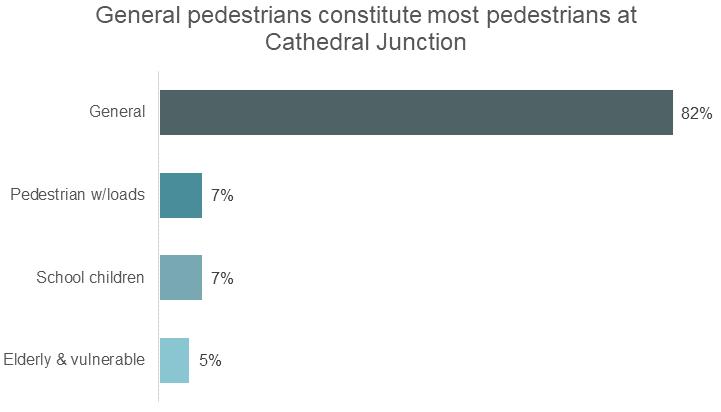
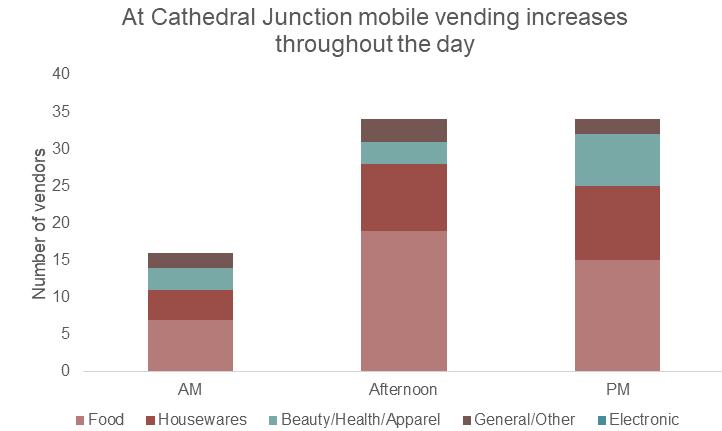
1” = 100’
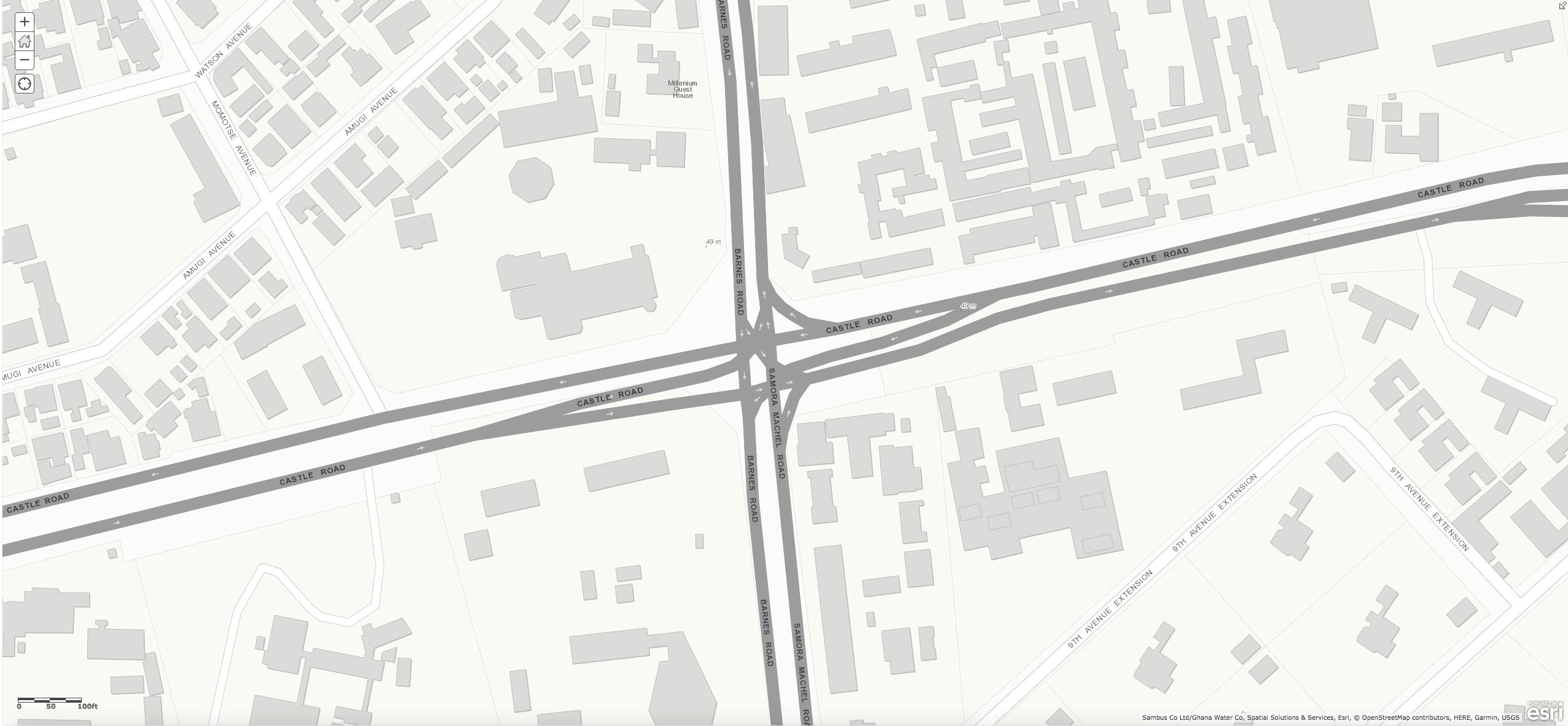
Figure 13. Morning Peak Period: Pedestrian Circulation
1” = 100’
Stopped Parked Pedestrian Traffic
Vehicle Traffic Vendor Stall
Hawker
Idle Pedestrian
Private Car
Taxi Motorcycle Tro-tro
Castle Rd
B a r n e s R d

1” = 50’
0 25 50 N
1” = 100’

Figure 16. Evening Peak Period: Pedestrian Circulation
1” = 100’
Stopped Parked Pedestrian Traffic
Vehicle Traffic Vendor Stall
Hawker
Idle Pedestrian
Private Car
Taxi Motorcycle Tro-tro
1” = 50’

0 25 50 N
Although Cathedral Junction does not have heavy pedestrian flows, those who must cross do so at high risk. The main risk to pedestrians is the high speed of oncoming traffic. In addition, pedestrian signals are ill-timed, and crosswalks are not well-placed.
Pedestrian Signals
Pedestrian signals, while operational, are not timed correctly with traffic. They direct pedestrians to cross into oncoming traffic and to wait when it is safe to cross. When pedestrians cannot see turning vehicles nor trust the pedestrian signals, they take a gamble each time they cross the streets. During the Co-Lab, AMA officials pointed out that signal timing malfunctions often arise from power failures. Power loss results in signal timers being reset, which in turn causes the system to lose synchronicity.
Pedestrian Exposure
Since the crosswalks are placed so far from the corner, pedestrians using the crosswalk are less visible to turning vehicles, and pedestrians waiting at the crosswalk similarly cannot see around the corners to check for turning cars. This diminished visibility makes crossing riskier. Many pedestrians choose to forego the crosswalks altogether because of their distance from the corner. However, this too has associated risks. Crosswalks are currently placed such that medians provide a shelter for pedestrians midway through the crossing. Those who cross closer to the intersection lose the valuable protection of the median. Cathedral Junction puts vulnerable populations at certain risks, especially considering the intersection is home to two health and psychiatric institutions. The intersection has well-marked crosswalks and multiple medians to break up the crossing; however, it also has several accessibility issues, as noted in the sections above.
Hospital Crossing
The mid-block crosswalk that connects the hospitals on either side of Castle Road does not sufficiently protect pedestrians. Road signs and a painted crosswalk warn drivers of pedestrian crossings but do little to slow oncoming traffic. Moreover, the crosswalk does not line up across the median, so pedestrians must walk along the narrow median strip if they wish to stay within the painted area while they cross. The narrowness of the median makes it difficult for several people to cross at once, and a pole in the median obstructs the path between the two sides of the crosswalk. The crosswalk is not wheelchair accessible, which is problematic for hospital clientele.
Dangerous Moto Driving
Similar to Wato Junction, motorcycles pose one of the greatest risks to pedestrians in Cathedral Junction. They frequently weave through stopped traffic, disobey red lights, travel against traffic patterns, and come up on sidewalks, seriously endangering pedestrians. They impose a heightened threat to hawkers who take advantage of stopped traffic to sell their goods. Often, motorcyclists travel in between traffic lanes where hawkers, who are selling, may not be able to see them coming.

